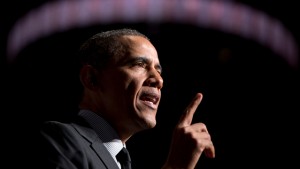
President Barack Obama speaks at Al Sharpton’s National Action Network conference in New York, Friday, April 11, 2014. (AP Photo/Carolyn Kaster)
This column originally appeared in the LA Times.
Stymied by the partisan gridlock, President Obama’s recent directives to bar federal contractors from discriminating against gay employees and to cut carbon pollution are bold examples of how presidents have used their executive powers to address critical issues when Congress has failed to adopt much-needed legislation.
For example, in 1961, as civil rights protests were gaining momentum, President Kennedy used his executive powers to order firms doing business with the federal government to refrain from discriminating against employees based on their race. President Johnson in 1965 issued an executive order establishing the Office of Federal Contract Compliance to implement this mandate to use “affirmative action” to address racial discrimination by employers.
Today, America faces another crisis — the widening gap between the rich and everyone else — that threatens our way of life. The richest 1 percent of Americans have a net worth 288 times greater than the median household, a record. Growing inequality is shrinking the middle class and limiting upward mobility.
Frustration over the huge income gap has galvanized workers. Recently, employees at major fast-food chains, Wal-Mart stores and the ports have resorted to strikes, rallies and civil disobedience to draw attention to low wages. They’ve demanded that hugely profitable corporations provide living wages and allow workers to collectively bargain so they can negotiate, rather than strike, to improve wages and conditions. In the nation’s capital, hundreds of low-wage federal contract workers walked off their jobs seven times in the last year at landmark federal buildings such as the Pentagon.
In February, Obama signed an executive order that raises the minimum wage of new federally contracted workers to $10.10 an hour. But there’s more the president can do to reduce the gap between the rich and poor, which he has called the “defining challenge of our time.”
In a December speech, the president recognized that workers need more than a minimum-wage hike to join the middle class; they also need unions. He observed that “laws establishing collective bargaining” had “contributed to rising standards of living for massive numbers of Americans.”
The president should heed his own words and require companies with federal contracts to bargain with employees over fair wages and working conditions in return for a commitment not to strike. The executive order should state emphatically that taxpayers should not subsidize corporations that mistreat their workers. It should give preference in federal contracting to companies with track records of good labor relations.
Too many companies with federal contracts routinely violate labor laws, firing or demoting workers who try to unionize. These firms do so without suffering any consequences, such as withdrawal of their contracts or fines sufficiently large to deter such illegal activities.
The US government spends more than $1.3 trillion with companies that employ more than 2 million workers with low-wage jobs, according to reports by Demos, a nonprofit think tank. These people work for firms that make clothing, weapons and other products for the military; firms that get FEMA contracts to rebuild communities damaged by natural disasters; fast-food corporations that operate on military bases and in federal buildings; companies that hire janitors and other workers to maintain federal buildings and privately owned office buildings leased by federal agencies.
There is precedent for presidential action to improve workers’ rights. In 1942, President Franklin D. Roosevelt issued Executive Order 9017 to ensure that strikes did not impede the war effort. The order established the National War Labor Board, which often required employers to recognize unions and bargain collectively with employees in exchange for workers taking a no-strike pledge. As a result, unions added millions of workers to their ranks, which after the war helped build the biggest middle class in history.
If Obama wants to exercise transformative leadership to address income inequality, he should follow in FDR’s footsteps to give workers a stronger voice.
A number of cities and states have “labor peace” agreements for companies that do business with government agencies. Last month in Los Angeles, for example, the Airport Commission instituted a policy to ensure its contractors guarantee that worker grievances are resolved through negotiation without resort to strikes, demonstrations and boycotts. By mandating a system of collective dispute resolution, the Los Angeles measure effectively ends years of management-led efforts to illegally oppose workers’ efforts to join together.
The president can restore the original spirit and purpose of American labor law, which — as spelled out in the National Labor Relations Act — is to “encourage the amicable settlement of disputes between employees and employers.” He would also send a powerful message to Wal-Mart, fast-food chains such as McDonald’s and Taco Bell, and other employers that corporations have a legal responsibility to give their employees a voice at work so they don’t have to resort to strikes and protests to join the middle class.
The views expressed in this post are the author’s alone, and presented here to offer a variety of perspectives to our readers.


